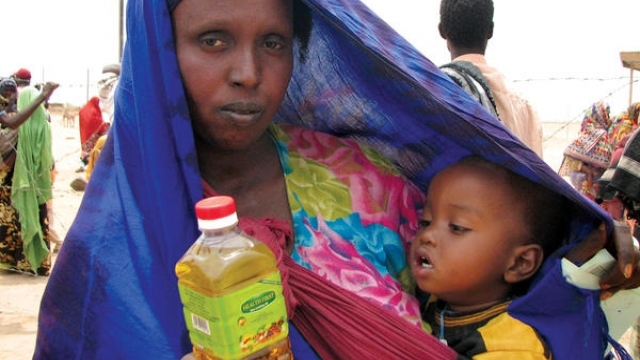 Ethiopia: Mother Lula Robe, with baby Nasre, holds cooking oil provided by the UN’s World Food Program. Most of the family’s livestock in the Oromo region died during the current drought. (William Davison)
Ethiopia: Mother Lula Robe, with baby Nasre, holds cooking oil provided by the UN’s World Food Program. Most of the family’s livestock in the Oromo region died during the current drought. (William Davison)
Tadias Magazine
Editorial
Updated: Wednesday, July 27, 2011
New York (Tadias) – A humanitarian crisis of historic proportions is unfolding in drought-hit areas of East Africa, including Somalia, Ethiopia, Djibouti and Kenya. The United Nations says the pending disaster is the largest famine in 60 years.
The UN warns relief is needed urgently and should not be ignored or the world will once again be witnessing the repeat of history, this time on a much larger scale. Unless quickly prevented, nearly 12 million people are thought to be at risk of food insecurity in the Horn of Africa this year. That’s an alarmingly large number of people affected in contrast to the widely publicized 1984 famine that killed approximately one million people. Ethiopians constitute 4.56 million of the current total food insecure populations in the region.
Sadly, the familiar images of hungry children with skinny, malnourished bodies on television screens and front-pages of newspapers around the world, conjures depressing sense of déjà vu for the international community. According to UNICEF, in total 2.23 million children in Ethiopia, Kenya and Somalia are estimated to be acutely malnourished. And nearly 720,000 children are at risk of death without immediate assistance.
Dr. Reuben Brigety, Deputy Assistant Secretary of State for Population, Refugees and Migration, said in a testimony before the House Subcommittee on Africa earlier this month that “in Ethiopia, global acute malnutrition rates close to 50% have been reported among newly arriving refugee children.” Dr. Brigety added: “This situation is substantially worse than when I last visited the Dolo Odo refugee camps in Ethiopia in February of this year. Newly arriving children are now dying in the refugee camp at the rate of two to three per day.”
The United Nations Food and Agricultural Organization held an emergency meeting in Rome recently to discuss campaign strategy to moblize and deliver aid to the region. The meeting was attended by representatives from the G20 countries, ministers and senior officials from UN’s 191 member nations, other U.N. bodies, NGOs and regional development banks.
The UN has officially declared famine in parts of Somalia and it has designated large areas in Ethiopia, Djibouti and Kenya as a crisis or an emergency zone. But the organization says the disaster is likely to expand beyond Somalia in the next few weeks and spread into Kenya, Uganda and Ethiopia.
Watch: UN Declares Famine in Somalia, Channel 4 News
“This summer has been an unspeakable nightmare for millions of children in the Horn of Africa,” said President and CEO of the U.S. Fund for UNICEF Caryl Stern. “We cannot control the weather patterns that have led to drought and famine, but we can do something about helping those who suffer from it. The sooner we act, the more children’s lives can be saved. As little as $10 can feed a child for 10 days.”
UNICEF estimates it will need $100 million over the next six months for a massive scale up of operations to reach children in the drought affected areas with emergency and preventative assistance.
“UNICEF is using every means possible to reach every child. There simply can be no compromise on the objective to keep children and their families alive,” said Elhadj As Sy, Regional Director for UNICEF Eastern and Southern Africa. “We appreciate the generosity of the international community and those contributions are already making a difference. We urgently need more funds to meet the enormous need.”
————-
For more information or to make a tax-deductible contribution to relief efforts in the Horn of Africa, please contact the U.S. Fund for UNICEF: Website: www.unicefusa.org/donate/horn. Or call toll free: 1-800-4UNICEF (1-800-486-4233). Text: Text “FOOD” to UNICEF (864233) to donate $10. Mail: 125 Maiden Lane, New York, NY 10038.
Click here to join the discussion on this topic.
Video: East Africa Food Crisis – Somalia Faces Famine as al-Qaida Threat Halts International Aid


























2 Responses to “Historic Famine in East Africa Conjures Depressing Sense of Deja Vu”